Practice Free AZ-104 Exam Online Questions
HOTSPOT
You have a Microsoft Entra tenant.
You need to modify the Default user role permissions settings for the tenant.
The solution must meet the following requirements:
* Standard users must be prevented from creating new service principals.
* Standard users must only be able to use PowerShell or Microsoft Graph to manage their own Azure resources.
Which two settings should you modify? To answer, select the appropriate settings in the answer area. NOTE: Each correct answer is worth one point.
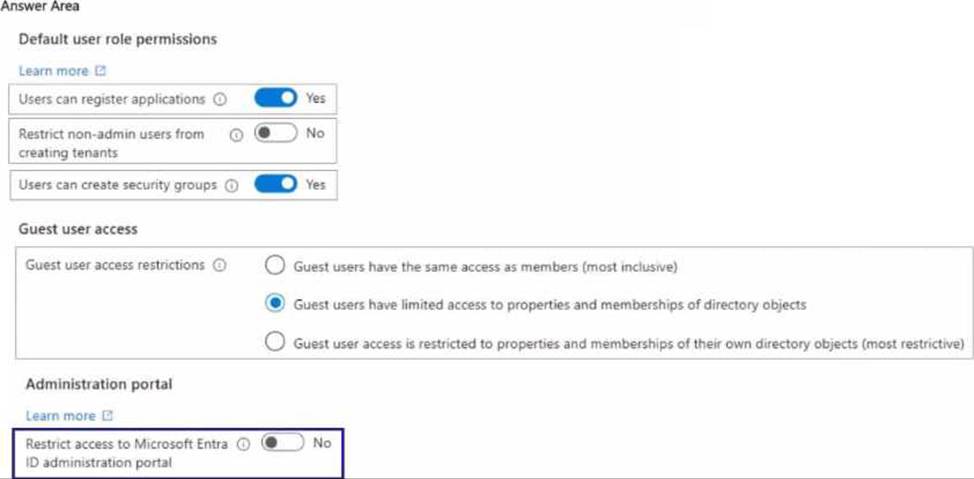
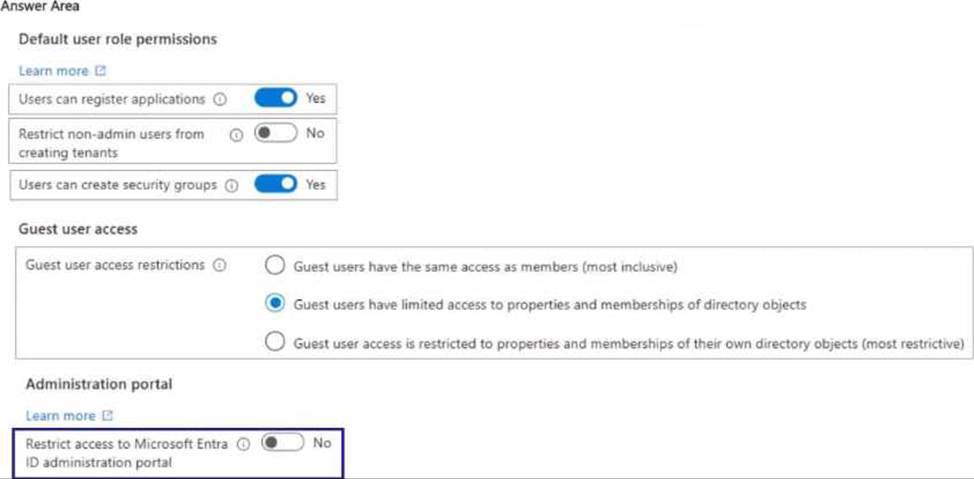
Yon have an Azure Storage account named storage1 that contains a blob container named comainer1. You need to prevent new content added to contalner1 from being modified for one year.
What should you configure?
- A . an access policy
- B . the access level
- C . the access tier
- D . the Access control (JAM) settings
You have an Azure subscription that contains a container group named Group1.
Group1 contains two Azure container instances as shown in the following table.

You need to ensure that container2 can use CPU resources without negatively affecting container1.
What should you do?
- A . Increase the resource limit of container1 to three CPUs.
- B . Increase the resource limit of container2 to six CPUs.
- C . Remove the resource limit for both containers.
- D . Decrease the resource limit of container2 to two CPUs.
You need to ensure that VM1 can communicate with VM4. The solution must minimize administrative effort.
What should you do?
- A . Create a user-defined route from VNET1 to VNET3.
- B . Assign VM4 an IP address of 10.0.1.5/24.
- C . Establish peering between VNET1 and VNET3.
- D . Create an NSG and associate the NSG to VMI and VM4.
B
Explanation:
Reference: https://docs.microsoft.com/en-us/azure/vpn-gateway/tutorial-site-to-site-portal
You have an Azure virtual machine named VM1 that runs Windows Server 2019.
You save VM1 as a template named Template1 to the Azure Resource Manager library.
You plan to deploy a virtual machine named VM2 from Template1.
What can you configure during the deployment of VM2?
- A . virtual machine size
- B . operating system
- C . administrator username
- D . resource group
D
Explanation:
Resource Group is the correct answer: Admin user, password, vm size and os are the part of ARM templates. But resource group is not hence needs to be mentioned while deployment! Refer below sample ARM template for reference in which all above attributes passed in parameter. https://github.com/Azure/azure-quickstart-templates/blob/master/101-vm-simple-windows/azuredeploy.json
You have an Azure subscription that contains the virtual machines shown in the following table. javascript:void(0)

You deploy a load balancer that has the following configurations:
• Name: LB1
• Type internal
• SKU: Standard
• Virtual network VNET1
You need to ensure that you can add VM1 and VM2 to the backend pool of LB1.
Solution: You create a Basic SKU public IP address, associate the address to the network interface of VM1, and then start VM1.
Does this meet the goal?
- A . Yes
- B . No
B
Explanation:
You can only attach virtual machines that are in the same location and on the same virtual network as the LB. Virtual machines must have a standard SKU public IP or no public IP.
The LB needs to be a standard SKU to accept individual VMs outside an availability set or vmss. VMs do not need to have public IPs but if they do have them they have to be standard SKU. Vms can only be from a single network. When they don’t have a public IP they are assigned an ephemeral IP.
Also, when adding them to a backend pool, it doesn’t matter in which status are the VMs.
Note: Load balancer and the public IP address SKU must match when you use them with public IP addresses.
You have an Azure subscription that contains the virtual machines shown in the following table. javascript:void(0)

You deploy a load balancer that has the following configurations:
• Name: LB1
• Type internal
• SKU: Standard
• Virtual network VNET1
You need to ensure that you can add VM1 and VM2 to the backend pool of LB1.
Solution: You create a Basic SKU public IP address, associate the address to the network interface of VM1, and then start VM1.
Does this meet the goal?
- A . Yes
- B . No
B
Explanation:
You can only attach virtual machines that are in the same location and on the same virtual network as the LB. Virtual machines must have a standard SKU public IP or no public IP.
The LB needs to be a standard SKU to accept individual VMs outside an availability set or vmss. VMs do not need to have public IPs but if they do have them they have to be standard SKU. Vms can only be from a single network. When they don’t have a public IP they are assigned an ephemeral IP.
Also, when adding them to a backend pool, it doesn’t matter in which status are the VMs.
Note: Load balancer and the public IP address SKU must match when you use them with public IP addresses.
HOTSPOT
You have an Azure subscription named Subscription1 that contains the virtual networks in the following table.
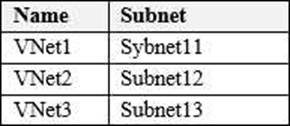
Subscripton1 contains the virtual machines in the following table.
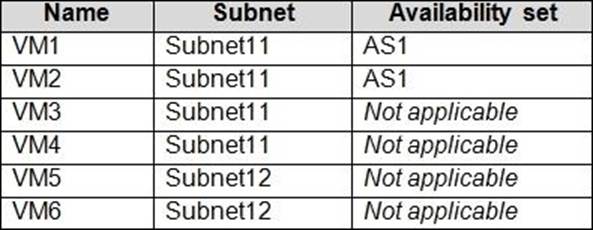
In Subscription1, you create a load balancer that has the following configurations:
✑ Name: LB1
✑ SKU: Basic
✑ Type: Internal
✑ Subnet: Subnet12
✑ Virtual network: VNET1
For each of the following statements, select Yes if the statement is true. Otherwise, select No. NOTE: each correct selection is worth one point.

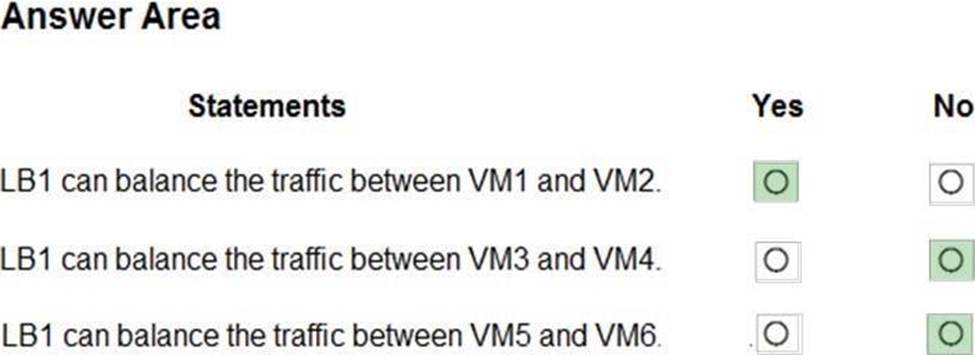
You have an Azure subscription.
You plan to deploy the resources shown in the following table.

You need to create a single Azure Resource Manager (ARM) template that will be used to deploy the resources.
Which resource should be added to the dependsOn section for VM1?
- A . IP1
- B . VNET1
- C . NIC1
- D . NSG1
You have an Azure subscription named Subscription1 that contains the storage accounts shown in the following table:

You plan to use the Azure Import/Export service to export data from Subscription1.
Which account can be used to export the data.
What should you identify?
- A . storage1
- B . storage2
- C . storage3
- D . storage4
D
Explanation:
Azure Import/Export service supports the following of storage accounts:
✑ Standard General Purpose v2 storage accounts (recommended for most scenarios)
✑ Blob Storage accounts
✑ General Purpose v1 storage accounts (both Classic or Azure Resource Manager deployments),
Azure Import/Export service supports the following storage types:
✑ Import supports Azure Blob storage and Azure File storage
✑ Export supports Azure Blob storage. Azure Files not supported.
Only storage4 can be exported.
Reference: https://docs.microsoft.com/en-us/azure/storage/common/storage-import-export-requirements
